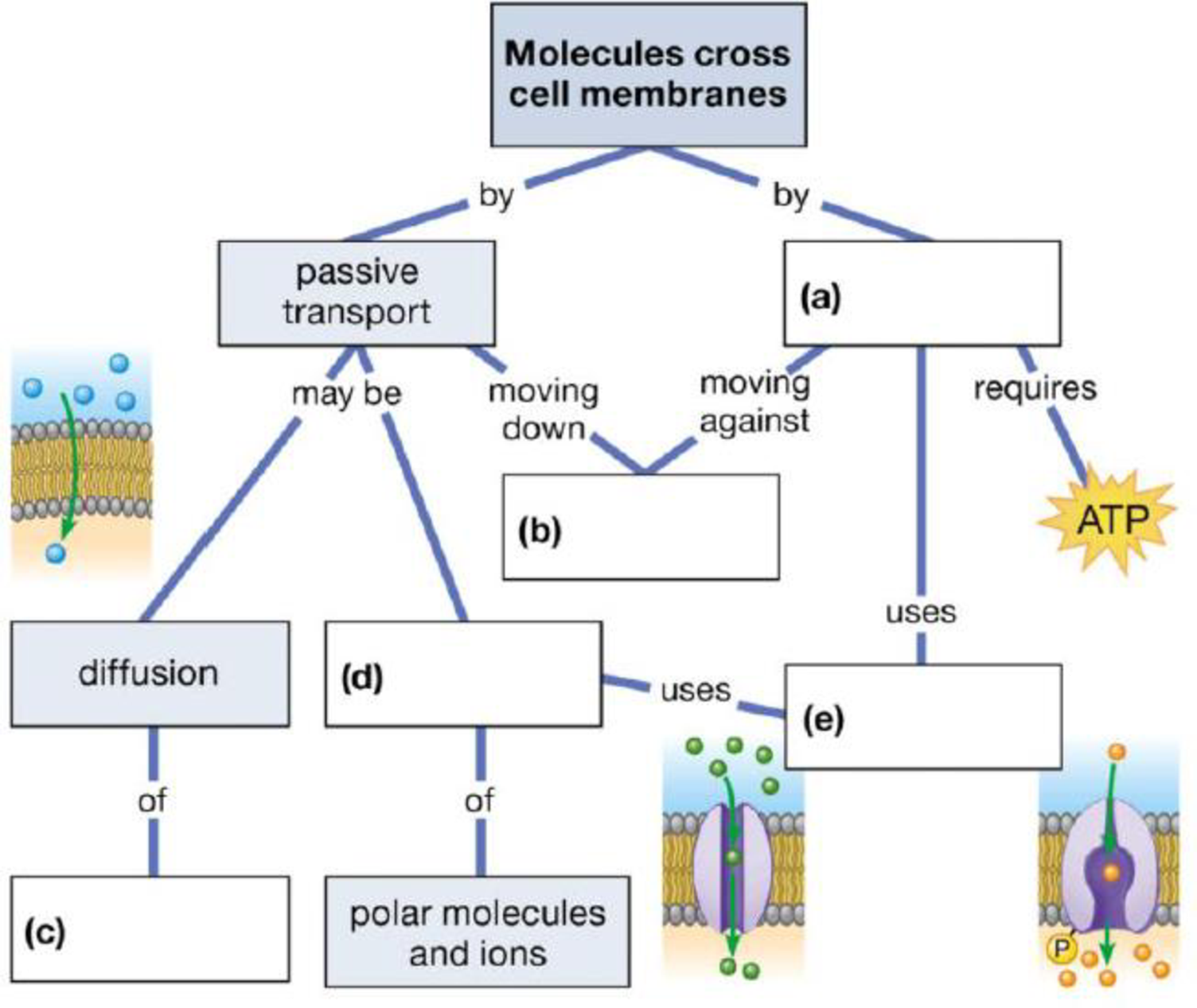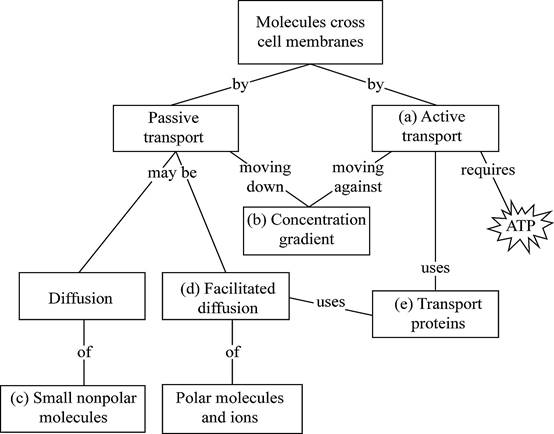
Concept explainers
Fill in the following concept map to review the processes by which molecules move across membranes.

To complete: The given map showing the process by which the molecules move across the cell membrane.
Introduction:
The plasma membrane is selectively permeable, and it allows the movement of substances in and out of the cells. The two main types of transport are active transport and passive transport.
Answer to Problem 1CC
Pictorial representation: The Fig.1 shows the movement of molecules between cells through the cell membranes.

Fig.1: The process involved in the transport of molecules across the cell membrane
Explanation of Solution
(a)
Correct answer: Active transport
Explanation: Active transport is an energy-dependent process in which the molecules are moved from a region of lower concentration to a region of higher concentration against their concentration gradient, and it requires energy in the form of ATP. Hence, the correct answer is Active transport.
(b)
Correct answer: Concentration gradient
Explanation: The concentration gradient is the difference in the concentration of the solutes. Active transport moves the molecules against their concentration gradient, whereas passive transport moves the solutes along with their concentration gradient. Hence, the correct answer is Concentration gradient.
(c)
Correct answer: Small nonpolar molecules
Explanation: A molecule is said to be nonpolar when there is a symmetrical arrangement of polar bonds in a complex molecule or if there is an equal sharing of electrons between the two atoms. These small nonpolar molecules can diffuse across the membrane. Example: Oxygen and carbon dioxide are the two nonpolar molecules that can undergo simple diffusion. Hence, the correct answer is Small nonpolar molecules.
(d)
Correct answer: Facilitated diffusion
Explanation: Facilitated diffusion is a passive transport where the molecules diffuse across the plasma membrane with the help of the membrane proteins such as carriers and channels. This transport does not require energy, and it moves the solute down the concentration gradient. Hence, the correct answer is Facilitated diffusion.
(e)
Correct answer: Transport proteins
Explanation: Transport proteins are a type of proteins used to move the substances across the cell membrane. They are mainly of two types: channel proteins and carrier proteins. Channel proteins are used to transport ions in and out of the cell, and carrier proteins are used to transport macromolecules, ions, and small molecules by changing their shape or conformation. Hence, the correct answer is Transport proteins.
Want to see more full solutions like this?
Chapter 5 Solutions
Campbell Biology Concepts and Connections, Third custom edition for Orange Coast College, Includes Online Access code.
- Note that the number of transport proteins (pores) on a cell and their size can help the cell to control which kinds of molecules are inside and in what quantities. Link to the website: Next-Generation Molecular Workbench (concord.org)arrow_forwardDraw and label a cell lipid bilayer and diagram how the following transport processes take place: passive diffusion of oxygen into the cell, facilitated diffusion of potassium into the cell, active transport of sucrose into the cell. Using different symbols (circles for oxygen, squares for sucrose, and triangles for potassium ions), show the relative concentrations (gradients) of these substances on the inside and outside of the cell. For example, to show that oxygen enters the cell by going “down” its gradient, you would draw more circles on the outside of the cell than inside the cell. Be sure to show and label membrane proteins when appropriate, and show the electric membrane potential using “+”s (pluses) on one side and “-”s (minuses) on the other side of the membrane. Also show the proton pump which uses ATP as a source of energy.arrow_forwardDO NOT COPY THE ANSWER FROM THE SAME QUESTION. Sassa, a biology professor, wanted to demonstrate to her students the applicability of a dialyzing membrane (DM) as a model for the cell membrane by enclosing an aqueous solution in a DM bag and immersing in a beaker containing a different solution. Substances available which are permeable to the DM include 0.02 M NaCl, 0.03 M glucose, and 0.01 M glucose. The only substance available which is completely impermeable to the DM is the 0.01 M lactose. Using the substances given and materials such as a beaker, stirring rod, and string, draw ONLY ONE set-up that can be demonstrated by Ms. Sassa that will satisfy ALL of the following conditions:a. No solute will exhibit a net diffusion out of the cell.b. Glucose will exhibit a net diffusion into the cell.c. NaCl will exhibit a zero net d. No net movement of lactose from the inside to outside of the cell. Make sure to label properly the substance inside the beaker and inside the DM bag.arrow_forward
- Membrane proteins are key components of a typical cell membrane. Explain the importance of the proteins inside membranes to the cell membrane itself, and overall life. Include a diagram that illustrates . Your labelled diagram needs to show two different types of transport proteins embedded within a typical cell 1. membrane. 2. Serine is an uncharged, polar amino acid (below and left). Threonine (below and right) is another uncharged, polar amino acid. Illustrate the hydrolysis of a dipeptide that was made from these two amino acids. Be sure to write all involved reactants and products in the structural form like Serine, and as a proper chemical equation; e.g. reactant(s) - product(s). Your diagram of the dipeptide must show the N-terminal and C-terminal ends at opposite sides of the dimer molecule, and you need to indicate where the peptide bond is with an arrow/highlighter. „H C-N OH NH2 но CH — CH -с-соон он Harrow_forwardWhich of the following statements are correct about how the complex biological matrix of the cell may affect protein folding, stability and function (select all that appy)? A. ATP tends to "bounce" along the surfaces of many proteins without forming a stable complex B. Proteins make up approximately 30% of the total volume of the cytoplasm in a typical cell C. Compettition between drug molecules and metabolites in the cytoplasm may cause unexpected drug side effects not seen with individual proteins in solution. D. Large protein complexes move faster through the cytoplasm than small metabolites. E. Complex intercations between proteins in the cell may significantly destabilize a protein compared to the isolated protein in waterarrow_forwardDrawn below is a schematic of a transmembrane protein. Extracellular Cell membrane Cytosolic side (a) From the list below, select the amino acid(s) that might by more common in the extracellular domain of this membrane protein and whose side- chain can form hydrogen bonds with the surrounding water molecules. Explain why you selected this option(s). Lysine Serine Phenylalanine Methionine (b) From the list below, select the amino acid(s) that would likely be found in the transmembrane/ membrane spanning domain of this protein and whose side- chain interacts with the lipid bilayer. Lysine Serine Phenylalanine Methioninearrow_forward
- A bioengineer spreads 5 mL of oil onto the surface of a table and observes that the oil covers an area of 2,000 m2. A. This oil is composed of fatty acids. Will the thickness of the oil film be an approximate value of the thickness of a biological membrane? Please, explain your answer.arrow_forwardControlled exchange of materials occurs between compartments and across cellular membranes. Explain?arrow_forwardExplain the structure of a biological membrane. Be sure to address how the phospholipids, proteins, glycolipids and glycoproteins are organized to create the biological membrane.arrow_forward
- Summarize some important ideas and words related to the fluid mosaic model of membranes. From the table below, make a straight line (horizontal, vertical or diagonal) by choosing three words that you can connect in a complete sentence or thought. cell-to-cell communication glycoprotein boundary cholestrol amphipathic integral protein phospholipid shape fluidarrow_forwardTwo theories of membrane structure are discussed below. Unit Membrane Model Phospholipid molecules are the most abundant type of lipids in cell membranes. Each consists of a nonpolar, hydrophobic tail, and a polar, hydrophilic head. The phospholipid chains orient themselves to form a bilayer with the tails pointed inward and the hydrophilic heads lined up on both sides of the bilayer. An extended monomolecular layer of protein coats both the outside of the membrane and the inside of the bilayer, but the protein does not penetrate the bilayer. When thin slices of membranes were examined with an electron microscope, three layers were seen: two electron-dense layers, with one wider layer between them. It was believed that the electron-dense layers represented proteins, and the lighter area represented lipids. Fluid Mosaic Model The structure of the fluid mosaic membrane is a bilayer of phospholipid molecules with proteins inserted into the bilayer. Hydrophilic regions of both the lipids…arrow_forwardMembranes are effective barriers preventing the crossing of both polar and nonpolar molecules from one side to the other. Explain why it is difficult for any species to pass from one side of a membrane to the other, more specifically explain how membranes are able to keep polar molecules out of the cell, keep nonpolar molecules out of the cell and what region of the membrae the polar and nonpolar/ hydrophilic molecules will not like being assoicated with.arrow_forward
 Human Anatomy & Physiology (11th Edition)BiologyISBN:9780134580999Author:Elaine N. Marieb, Katja N. HoehnPublisher:PEARSON
Human Anatomy & Physiology (11th Edition)BiologyISBN:9780134580999Author:Elaine N. Marieb, Katja N. HoehnPublisher:PEARSON Biology 2eBiologyISBN:9781947172517Author:Matthew Douglas, Jung Choi, Mary Ann ClarkPublisher:OpenStax
Biology 2eBiologyISBN:9781947172517Author:Matthew Douglas, Jung Choi, Mary Ann ClarkPublisher:OpenStax Anatomy & PhysiologyBiologyISBN:9781259398629Author:McKinley, Michael P., O'loughlin, Valerie Dean, Bidle, Theresa StouterPublisher:Mcgraw Hill Education,
Anatomy & PhysiologyBiologyISBN:9781259398629Author:McKinley, Michael P., O'loughlin, Valerie Dean, Bidle, Theresa StouterPublisher:Mcgraw Hill Education, Molecular Biology of the Cell (Sixth Edition)BiologyISBN:9780815344322Author:Bruce Alberts, Alexander D. Johnson, Julian Lewis, David Morgan, Martin Raff, Keith Roberts, Peter WalterPublisher:W. W. Norton & Company
Molecular Biology of the Cell (Sixth Edition)BiologyISBN:9780815344322Author:Bruce Alberts, Alexander D. Johnson, Julian Lewis, David Morgan, Martin Raff, Keith Roberts, Peter WalterPublisher:W. W. Norton & Company Laboratory Manual For Human Anatomy & PhysiologyBiologyISBN:9781260159363Author:Martin, Terry R., Prentice-craver, CynthiaPublisher:McGraw-Hill Publishing Co.
Laboratory Manual For Human Anatomy & PhysiologyBiologyISBN:9781260159363Author:Martin, Terry R., Prentice-craver, CynthiaPublisher:McGraw-Hill Publishing Co. Inquiry Into Life (16th Edition)BiologyISBN:9781260231700Author:Sylvia S. Mader, Michael WindelspechtPublisher:McGraw Hill Education
Inquiry Into Life (16th Edition)BiologyISBN:9781260231700Author:Sylvia S. Mader, Michael WindelspechtPublisher:McGraw Hill Education





